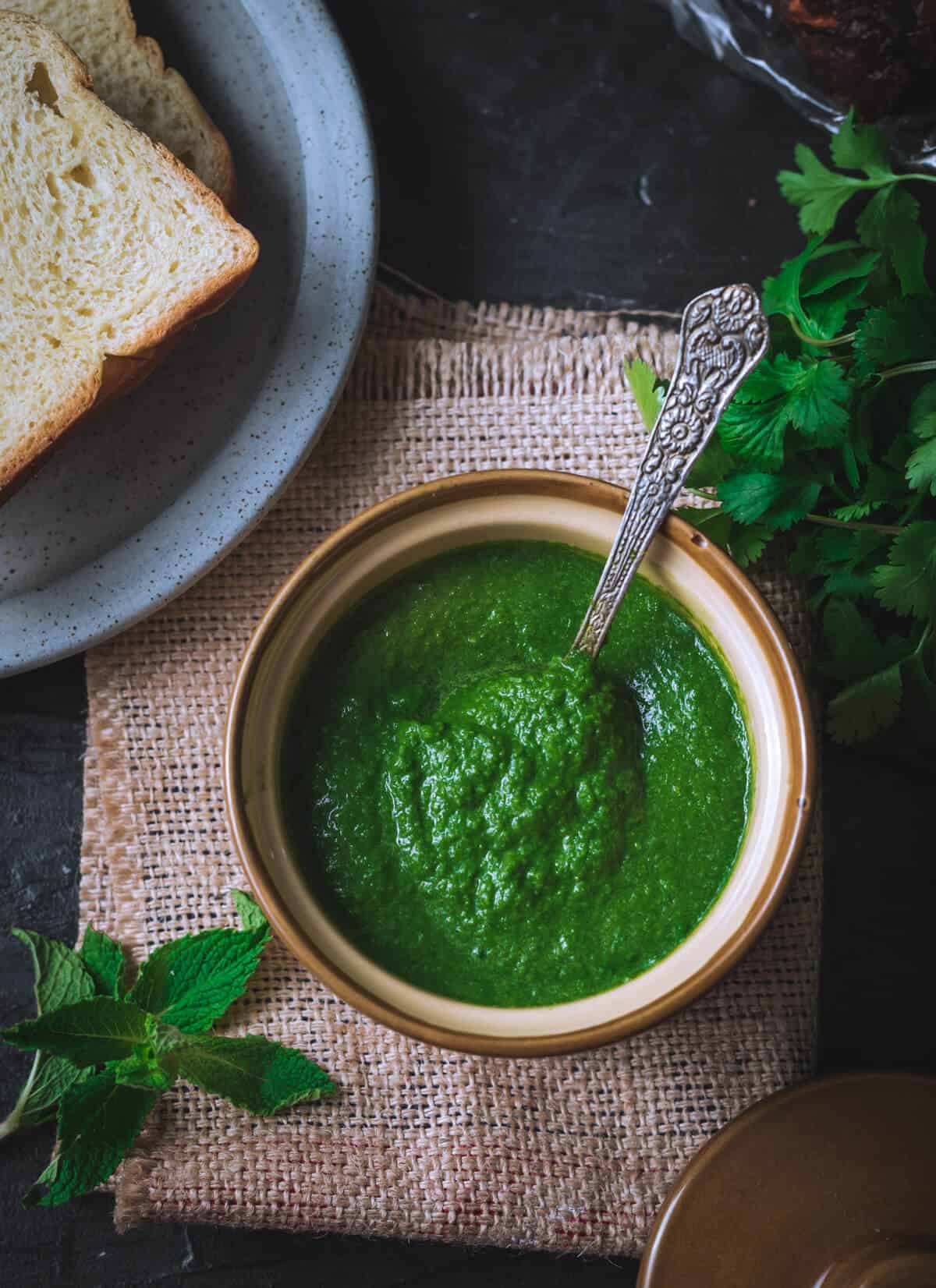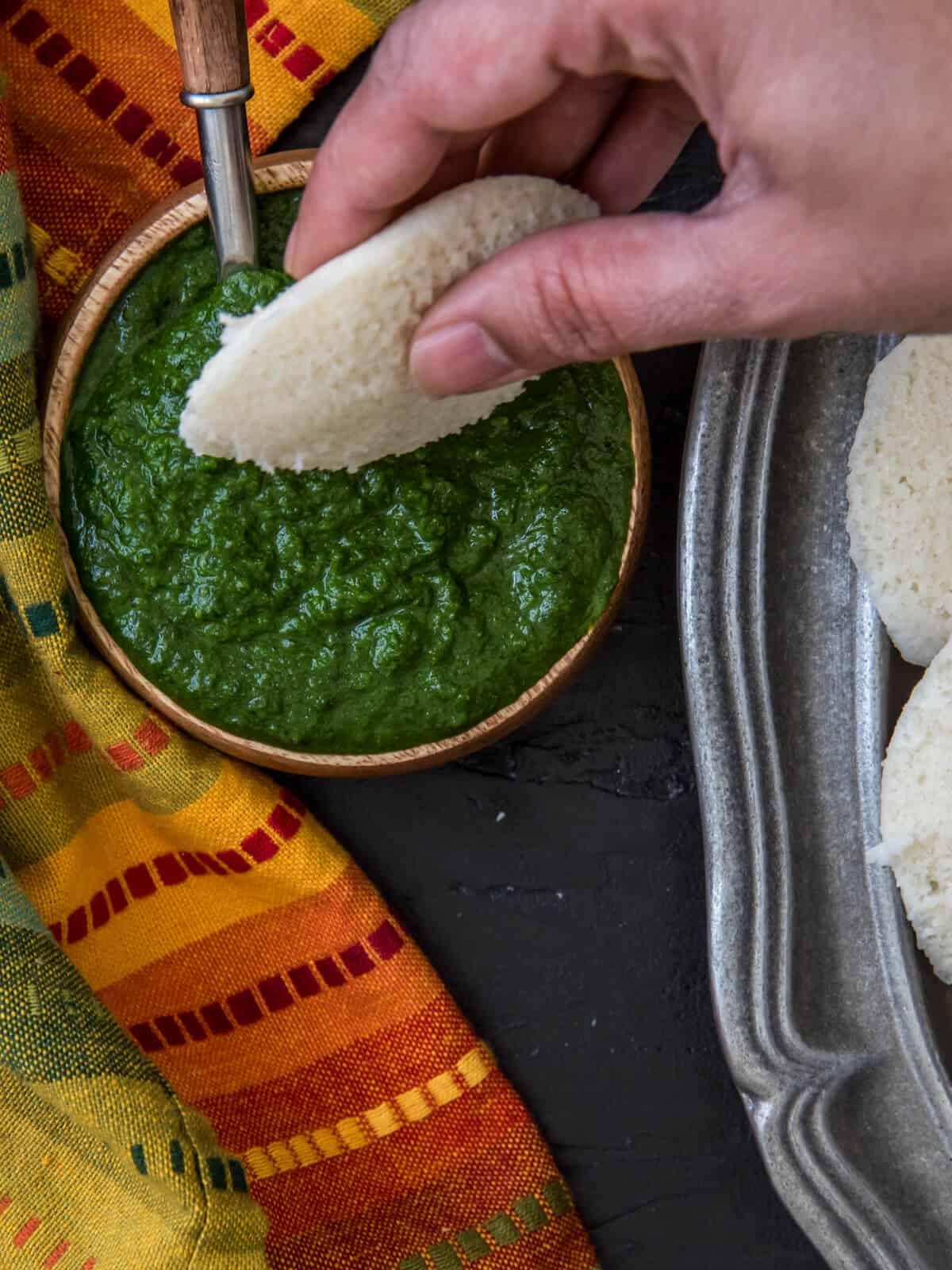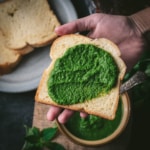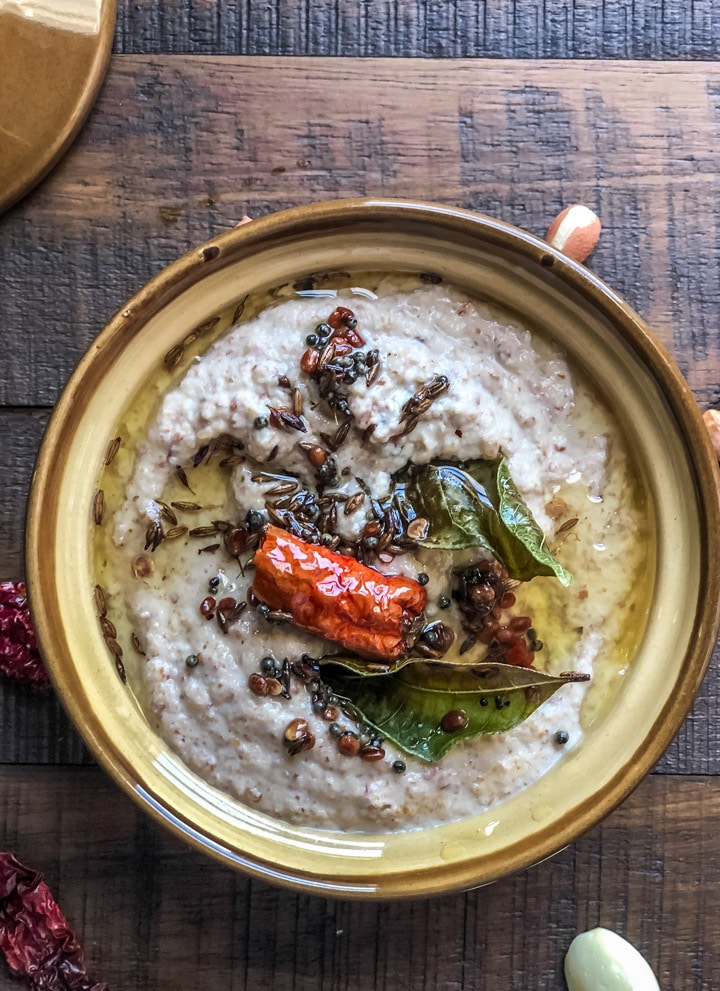Cilantro Mint Chutney (Green Chutney)
Note: This post contains affiliate links. As an Amazon Associate I earn from qualifying purchases.
Coriander mint chutney is this tangy green chutney that most Indian snacks can’t do without. This dipping sauce made from fresh cilantro and mint leaves comes together in less than 10 minutes!

All about coriander mint chutney
Imagine a sauce that captures the essence of Indian cuisine in every spoonful—that’s coriander mint chutney. It’s a vibrant green sauce made with fresh coriander, mint leaves, lemon juice, green chilies, and a few other ingredients.
This tangy chutney has a refreshing burst of flavor from the mint and a nice kick of heat that’s not too overwhelming. It’s commonly served in Indian restaurants as a side, along with date tamarind chutney to complement dishes like samosas or papadums.
The beauty of this chutney lies in its simplicity and the refreshing contrast it brings to the rich, savory flavors of our food. It’s definitely a must-try if you’re exploring Indian cuisine.
In Hindi, it’s known as hari chutney (“hari” meaning green) or dhaniya pudina chutney, with “dhaniya” referring to coriander and “pudina” to mint, highlighting its key ingredients.
How to make coriander-mint chutney
My mother-in-law is not the one to experiment with cooking. Yet, the few dishes she does make, she perfects—like this coriander mint chutney recipe, which is absolutely stellar. It’s so delicious that despite already having a cilantro chutney recipe on my blog, I felt this one deserved its own spotlight.
In this mint coriander chutney recipe, she uses tamarind and jaggery to create the perfect balance of sweetness and tanginess, a common practice in many South Indian homes. This blend of flavors makes the chutney utterly irresistible, compelling you to wipe your plate clean.
This Indian green sauce recipe is truly a game-changer. Go ahead and give it a try!

Ingredient notes/swaps
Making chutneys involves grinding vegetables, fruits, or herbs to a fine paste along with a host of other ingredients to enhance the flavor. Green chutneys are mostly made from fresh coriander leaves and, in this case, a combination of coriander and mint.
- Fresh cilantro/coriander leaves and mint leaves: The ratio may change from one household to the other, but we like to stick to 1:2, where for every 1 cup of fresh mint leaves, we use 2 cups of cilantro leaves.
- Tamarind and jaggery – Essential for that signature sweet and tangy taste. Tamarind lends tanginess, while jaggery adds sweetness. You can swap the tamarind with lime juice and jaggery with sugar, depending on what you have on hand.
- Green chilies, ginger, garlic, and salt – These ingredients are added for heat and depth of flavor, and they can be adjusted to suit your taste preferences.
- [Optional] Grated coconut for additional taste and texture. The addition of the coconut helps turn this chutney into a spread, making it perfect for sandwiches.
Be sure to check out the full recipe and ingredient list below.
Step-by-step instructions
- Prepare the tamarind: If using fresh tamarind, soak it in 1/2 cup of hot water for about 10 minutes. Strain through a sieve to extract the juice. Skip this step if using tamarind paste.
- Clean and pick the cilantro: Chop off the roots. Rinse the cilantro leaves under cold running water to remove any dirt or debris. Shake off the excess water. Gently remove the cilantro leaves from the stems. You can include some tender stems as they are flavorful, but discard any thick ones.
- Clean the mint leaves: Chop and discard any thick mint stems. Rinse the mint leaves under cold running water. Be gentle, as mint leaves can be delicate. Shake off any excess water or pat them dry with a clean kitchen towel.
- Blend the ingredients: In a blender or food processor, combine the cleaned cilantro and mint leaves, garlic cloves, ginger piece (or grated ginger), grated coconut, green chillies, powdered jaggery, salt, and the tamarind juice (or tamarind paste). Blend the mixture to a smooth paste.
- Serving: Your coriander & mint chutney is ready to enjoy! Serve it immediately, or store it in the refrigerator for later use.
Variations
There are so many different ways you can make cilantro and mint chutney. If you want to mix it up, you can try the following variations:
- Black Salt: Sprinkle in some black salt for that extra zing and a distinct flavor. It adds a unique earthiness that complements the freshness of the herbs.
- Yogurt-based chutney: Adding yogurt instead of coconut gives the chutney a creamy texture and a slightly tangy taste. This variation is great as a dip or a cooling side. If you’re planning to freeze the chutney, skip the yogurt, as it doesn’t freeze well. You could always incorporate the yogurt just before serving.
- Dried pomegranate seeds: Instead of tamarind, use dried pomegranate seeds to add tanginess. Remember, these are very potent, so start with 1/2 a teaspoon or less. They lend a sweet-tart flavor that’s absolutely delightful.
- Add peanuts: For a richer flavor and thicker consistency, incorporate 1/4 cup of roasted peanuts instead of grated coconut. This version works well as a spread for sandwiches or wraps.
- With chopped onions: Adding 1/4 cup of finely chopped onions can enhance the overall complexity of the chutney.
- Spicy chutney: For those who love a bit of heat, amp up the green chilies, or add red chili powder or black pepper.
- Sweet chutney: Increase the jaggery or add sugar for a sweeter contrast, perfect with savory bites.
These variations allow you to tailor cilantro mint chutney to your taste preferences or to suit the dishes you’re serving. Whether you opt for a traditional recipe or explore these adjustments, this Indian green chutney is sure to be a hit.
Authors notes
- When selecting fresh tamarind, choose a piece about 2 inches in size. If it’s quite soft and scoopable, just a tablespoon will do.
- The tanginess of tamarind can vary, so start by adding just half of the juice you’ve got. Then, taste the chutney and see if it needs more.
- You’ll often find that the juice from the tamarind is plenty, and there’s no need to add in extra water.
- If fresh tamarind isn’t on hand, no worries—1/2 teaspoon of tamarind paste or 1/2 tablespoon of lime juice makes a fine stand-in. And if you’re out of jaggery, feel free to use sugar instead.
- Be sure to remove the thick stalks from your cilantro and mint, as they can impart bitterness to your chutney.
- As for the quantity of mint, it’s a matter of personal preference. Start with half a cup, and if that’s to your liking, perfect. If not, feel free to increase it to a full cup.

How to store green chutney
Storing and prepping coriander mint chutney ahead of time can be a game-changer for those busy days. Here’s how to do it:
- Refrigeration: Store the chutney in an airtight container in the refrigerator. It usually keeps well for 4-5 days.
- Freezing: For longer storage, freezing the chutney is a great option. Spoon the chutney into ice cube trays, freeze until solid, and then transfer the cubes to a freezer bag or airtight container. Frozen chutney can last for 2-3 months. Thaw in the refrigerator before use.
Prep ahead instructions
- Ingredient prep: Wash and dry the cilantro and mint leaves ahead of time. Peel the garlic and ginger, and they’ll be ready to go. Store them in separate airtight containers in the refrigerator.
- Portion and freeze: If you often use chutney in small quantities, consider freezing it in individual portions using the ice cube method mentioned above. This way, you can thaw overnight in the refrigerator exactly the amount you need when you need it.
- Batch preparation: Making a big batch of chutney can save time. Just divide it into smaller portions for storage in the fridge or freezer, depending on when you plan to use it.
By following these storage and prep ahead tips you can enjoy delicious coriander mint chutney whenever the craving strikes without starting from scratch each time.
Troubleshooting chutney issues
- Too watery? Add grated coconut to thicken it up, and then adjust the seasonings.
- If the chutney is too tangy, add some jaggery or sugar.
- If the green chilies have ended up making your chutney spicy, counter it with jaggery/sugar.

Serving suggestions
This green chutney recipe complements a wide variety of Indian street foods, is perfect as a sandwich spread, and pairs perfectly with South Indian favorites such as idlis and dosas.
More delicious chutney recipes
Indians truly cherish their chutneys, each bringing its own unique blend of flavors to the table. If you’ve enjoyed this easy mint cilantro chutney, you’ll be delighted to explore the other chutney recipes featured on my blog.
This red chili coconut chutney, with its spicy, sweet, and tangy taste, will awaken your senses. Pair it with idlis or dosas for a wholesome breakfast.

The must-have chutney for most south Indian dishes such as Ven Pongal, Idli, Kapparutti, etc.
Here is a super easy, quick, yet delicious recipe for making this mouthwatering tamarind date (khajur imli) chutney at home using your Instant Pot. Stovetop instructions are included, too!
If you love peanuts, this Andhra-style peanut chutney is for you. Creamy and finger-licking good, this groundnut chutney is a perfect accompaniment to piping hot idlis, vadas, or dosas.
This zesty garlic chutney is what makes vada pav so tantalizingly good. It has a long shelf life, and you’ll find that it is a great way to amp up your meals.
Need more chutney recipes? Check out this list of 10+ delicious chutney recipes for fresh ideas to keep your meals interesting.
To wrap it up, this cilantro mint chutney is a total game-changer. It’s like the superhero of chutneys, ready to swoop in and save any Indian meal with a blast of flavor. Seriously, it’s so versatile!
Whether you’re jazzing up a sandwich, dunking your favorite street snacks, or adding a zing to South Indian classics like idlis and dosas, this chutney has you covered. Try this best mint coriander chutney, and let me know how you like it.

Coriander mint (dhaniya pudina) chutney recipe
Equipment
Ingredients
- 1 tablespoon fresh tamarind or 1/2 teaspoon tamarind paste
- ½ cup water
- 2 cups chopped cilantro/ coriander/dhania leaves
- 1 cup mint leaves
- 4 garlic cloves
- 2 inch ginger piece or 1 tablespoon grated ginger
- ½ cup grated coconut
- 1-2 Indian or Thai green chilies
- 2 tablespoons powdered jaggery
- ½ teaspoon salt or as needed
Instructions
- Prepare the tamarind: If using fresh tamarind, soak it in 1/2 cup of hot water for about 10 minutes. Strain through a sieve to extract the juice. Skip this step if using tamarind paste.
- Clean and pick the cilantro: Chop off the roots. Rinse the cilantro leaves under cold running water to remove any dirt or debris. Shake off the excess water. Gently remove the cilantro leaves from the stems. You can include some tender stems as they are flavorful, but discard any thick ones.
- Clean the mint leaves: Chop and discard any thick mint stems. Rinse the mint leaves under cold running water. Be gentle, as mint leaves can be delicate. Shake off any excess water or pat them dry with a clean kitchen towel.
- Blend the ingredients: In a blender or food processor, combine the cleaned cilantro and mint leaves, garlic cloves, ginger piece (or grated ginger), grated coconut, green chillies, powdered jaggery, salt, and the tamarind juice (or tamarind paste). Blend the mixture to a smooth paste.
- Serving: Your coriander & mint chutney is ready to enjoy! Serve it immediately, or store it in the refrigerator for later use.
Notes
- When selecting fresh tamarind, choose a piece about 2 inches in size. If it’s quite soft and scoopable, just a tablespoon will do.
- The tanginess of tamarind can vary, so start by adding just half of the juice you’ve got. Then, taste the chutney and see if it needs more.
- You’ll often find that the juice from the tamarind is plenty, and there’s no need to add in extra water.
- If fresh tamarind isn’t on hand, no worries—1/2 teaspoon of tamarind paste or 1/2 tablespoon of lime juice makes a fine stand-in. And if you’re out of jaggery, feel free to use sugar instead.
- Be sure to remove the thick stalks from your cilantro and mint, as they can impart bitterness to your chutney.
- As for the mint, it’s a matter of personal preference. Start with half a cup, and if that’s to your liking, perfect. If not, feel free to increase it to a full cup.
How to store green chutney
Storing and prepping coriander mint chutney ahead of time can be a game-changer for those busy days. Here’s how to do it:- Refrigeration: Store the chutney in an airtight container in the refrigerator. It usually keeps well for 4-5 days.
- Freezing: For longer storage, freezing the chutney is a great option. Spoon the chutney into ice cube trays, freeze until solid, and then transfer the cubes to a freezer bag or airtight container. Frozen chutney can last for 2-3 months. Thaw in the refrigerator before use.
Disclaimer: Approximate nutritional information is provided as a courtesy and can vary depending on the exact ingredients/brands used. If you have health issues, please work with a registered dietician or nutritionist.
Nutrition
This post was first published on March 14, 2019, and was updated with text and pictures on Feb 5th, 2024.









